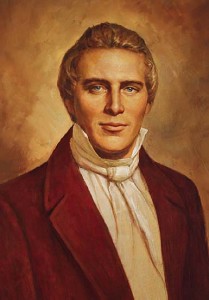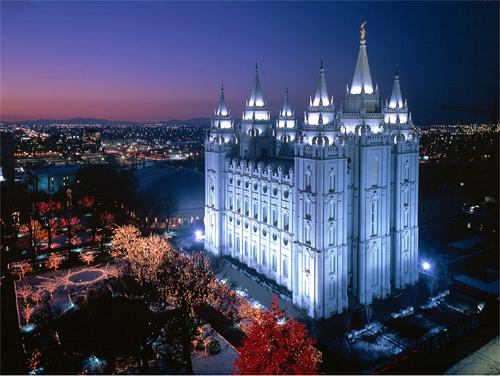|
||
Mormon HistoryThe Mormon Church was founded April 6, 1830, in Fayette, New York, by Joseph Smith and a few of his followers. The unique Mormon doctrines taught by Joseph Smith have provoked fellow Christians and non-believers alike to fight against the Mormons since the beginning. Before settling in Utah, Mormon history was plagued by persecution and the Church moved its headquarters several times. The Mormons found relative peace in Utah and began to expand into the international church it is today. The Founding of the Mormon Church
After a few years, in 1823, an angel of the Lord appeared to Joseph Smith and told him of an ancient record written on golden plates. It contained an account of the people of God on the American continent. Joseph was chosen to translate the record and proclaim its message to the world as a testament that the Church of Jesus Christ was restored to the earth. The record was entrusted to his care in September of 1827. Joseph Smith commenced translating the record into English by use of the Urim and Thummim, seer stones that were buried with the golden plates. The translation produced what is now the Book of Mormon. The Book of Mormon was published just a few days before the organization of The Church of Jesus Christ of Latter-day Saints by six individuals in Fayette, New York, on April 6, 1830. Kirtland, Ohio The first central location for the Church in Mormon history was Kirtland, Ohio in 1831. Later that year Joseph Smith received revelation that Jackson County, Missouri, was the location for the building of Zion, the Promised Land for the Mormons, and Ohio was only a temporary gathering place, while Missouri was prepared for their immigration. In Kirtland much of the Mormon Church organization was set up. The majority of the revelations contained in the Doctrine and Covenants were received in Kirtland, including the Word of Wisdom, the Mormon health code; and Joseph purchased and translated Egyptian papyri resulting in the Book of Abraham. It was also here that the first Mormon temple was built, completed in 1836, just before the Mormons left for Missouri. Joseph Smith had relocated the Mormons from New York under some persecution, but in Kirtland it became violent. The number of Mormons started to grow while the Church was headquartered in Kirtland, and the persecutions intensified. Joseph Smith had established the Kirtland Safety Society as a financial institution for the Mormons. When it failed, some Mormons became angry with Joseph and increased persecutions among neighboring communities. Those who had gone ahead to Missouri already were experiencing the same treatment, so Joseph decided to unite all the Mormons in Missouri. Independence, Missouri Mormons began buying up land in Missouri and establishing settlements as soon as Joseph Smith revealed that it would be the location of Zion. The settlers of Missouri saw the immigration of the Mormons as a political threat. Mormon converts showed an unwavering support for Joseph Smith and followed him in all things. The number of Mormons united behind the single voice of one man was seen as a theocracy by Missourians that threatened to take over their state. (The Mormons were also anti-slavery.) Fear of the Mormons gaining a stronghold prompted mob violence by the settlers and they drove the Mormons from Jackson County into neighboring Clay County near the end of the year 1833. Mormon leaders constantly petitioned the government for protection and justice but to little avail. A few months later a group of 200 men that called itself Zion’s Camp set out to reclaim the Mormons’ lands in Missouri and execute justice. But when they arrived, Joseph Smith decided to leave vengeance to the Lord and they returned to Ohio. In 1836 the settlers of Clay County, Missouri voted to expel the Mormons. The state of Missouri created Caldwell County for the Mormons to settle. Late in the year, Joseph Smith arrived in Caldwell County with all those from Kirtland. The Missouri settlers still wanted the Mormons and their political influence out of the state. Harassment and violence continued until Governor Lilburn W. Boggs issued an extermination order against the Mormons in October of 1838. Many Mormons were killed; Joseph Smith and several other leaders were captured and jailed, but the majority of Mormons escaped to Illinois. Nauvoo, Illinois The Mormons chose their new headquarters on the banks of the Mississippi in Hancock County, Commerce, Illinois. Joseph renamed the town Nauvoo and so began the Nauvoo chapter of Mormon history. The Mormons turned a veritable swamp into an industrious city. For a time, Nauvoo was the biggest city in the state of Illinois. Converts to the Mormon Church were immigrating from the Eastern U.S., Canada, and Europe. In 1840, just ten years after the Church was organized, the membership was 16,000. In the fall they began building another Mormon temple. During all this progress, enemies of the Mormons continued to threaten them. Missouri attempted to extradite Joseph Smith, and disaffected Mormons wrote attacks condemning him. Around this time the doctrine of polygamy was becoming better known. A few Mormon leaders began to practice polygamy, but they did so in secret to avoid greater persecutions. This issue may be the most controversial in Mormon Church history. Many members refused to accept it, left the Church, and joined in its persecution. The rumors of “strange sexual practices” (plural marriage) among the Mormons only intensified hatred towards them and Joseph Smith. In June 1844 a former Mormon published the only edition of the Nauvoo Expositor. It attacked Joseph Smith on polygamy and many other points and called for him to be hung. Joseph Smith, mayor of Nauvoo, and the city council decided the Expositor posed an imminent threat to the safety of Nauvoo and ordered it destroyed. The county sheriff sought Joseph Smith on charges of inciting a riot and Joseph surrendered himself at the request of Governor Ford. On June 27, 1844, a mob rushed the jail where Joseph and a few others were held, killing Joseph Smith and his brother Hyrum. The Mormons’ enemies thought the religion would fail after Joseph Smith’s death, and the people would return to where they came from, but Brigham Young took charge of the Mormons and they stayed. The persecution resumed and the Nauvoo charter was revoked in January 1845. There had been talk among Mormon leaders before Joseph’s death of moving to the Rocky Mountains. With approval received by revelation from the Lord, Brigham Young prepared the Mormons to go west and settle their own territory. In February 1846 the first company of Mormon pioneers crossed the Mississippi River. Utah Mormon pioneers established Winter Quarters, Nebraska, as a departure point for the migration. The bitter winter decimated the Mormon population, and hundreds died, unaided by the government. Led by Brigham Young, the first wagon train blazed the Mormon Trail to what is now Utah. On July 24, 1847, the company arrived in the Salt Lake Valley, and Young proclaimed it as the place the Mormons would settle. In a few years the Mormons had all gathered in Utah. Once they had established themselves in Salt Lake City, Brigham Young sent settlers to establish Mormon communities in southern Utah, Arizona, Idaho, and all around Salt Lake City to strengthen their resources. Mormon missionary efforts added to the number of Mormons daily. At the time, there were more Mormons in Europe than in America. Many of these immigrated to Utah, further increasing their numbers. In 1851 Brigham Young was appointed territorial governor. Feeling safer because of their geographic isolation, the Mormon Church publicly announced the practice of polygamy. The Mormon Church would be in jeopardy yet again. The Republican Party held that the two relics of barbarism remaining in the United States were slavery and polygamy. President James Buchanan used Mormon polygamy to distract the states from the bigger issue of slavery. Through rumor and hearsay he justified appointing a new governor and sending an army escort with him to get control of the Mormons. It was only ten years since the Mormons had arrived in Utah, and most of them had been the victims of mob violence in Missouri and Illinois. Some hoped for vengeance against the murderers of Joseph Smith. This new threat, under orders of the President, was seen as an act of war. This climate led to one of the most tragic events in Mormon history. The Mountain Meadows Massacre happened while the Mormons prepared to receive an invading army. The army was not able to make it to Utah as scheduled and tempers were cooled, preventing a bloody conflict. When the new governor arrived, Brigham Young peacefully resigned the governorship. The Civil War took the pressure off the Mormons for a time, but at its end, with slavery abolished, polygamy again became a target. Congress passed several laws targeting polygamy. Brigham Young openly lived in polygamy the remainder of his life, but after he died the government began to crack down. Many church leaders practicing polygamy were jailed or went into hiding. Pressure from the federal government increased until 1890 when Mormon Church president Wilford Woodruff announced a revelation from the Lord to end the practice of polygamy (Official Declaration 1). With this change more members left the Mormons or were excommunicated for refusing to abandon polygamy. President Grover Cleveland pardoned all Mormons who had entered into polygamy before 1890 as an act of goodwill. Growth of the Church Without polygamy to prevent it, Utah became a state in 1896 and Mormon history stabilized. The next problem the Mormon Church had to face was debt. Debts had accrued as the Mormons were driven from place to place. Then the U.S. government had frozen the assets of the Church. Members withheld donations because of the government’s actions. The fifth Church President, Lorenzo Snow, reemphasized the law of tithing to the Mormons. In a few years the Church was out of debt. Mormon leaders then worked hard to establish the reputation of the Mormon Church and build alliances to become part of the national and international community. Since World War II the Mormon Church has seen rapid growth. In 1947 Church membership was one million. By 1997 it was ten million. By 2009, it was approaching 14 million. The latest struggle of Mormon history has been international expansion. There are today more Mormons living outside of the United States than in it. With the addition of so many cultures to a church founded by Americans of Western European background, many steps have been taken to simplify the programs of the Church to the basics of the gospel which would accommodate all cultures and people. The Civil Rights movement in the U.S. and the growth of membership in Africa put pressure on Mormon leaders to reconsider their policy preventing black Mormons from holding the priesthood in the Mormon Church. President Spencer W. Kimball had long prayed about this topic and in 1978 announced the revelation from God allowing all worthy males to hold the priesthood and enjoy its blessings (Official Declaration 2).
The current Church leadership has led a campaign in defense of the traditional family. The nuclear family is the fundamental unit of the Mormon Church and current social trends are seen as damaging its sacred nature. Divorce, infidelity, homosexuality, pornography, and abuse are all condemned as moral and social ills threatening the foundation of civilization. In 1995 the Mormon Church issued The Family: A Proclamation to the World, reinforcing traditional family values as divinely instituted. Mormon history began with the miraculous vision of a farm boy in 1820 and has resulted in a worldwide church of over thirteen million members (2009) and fifty thousand missionaries converting two-hundred fifty thousand people a year throughout the world. Starting with six members in 1830, the Mormon Church has grown to be a highly respected international church in less than two-hundred years. |



